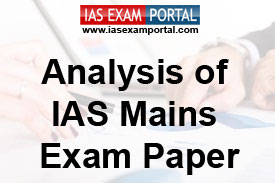(HOT) UPSC Current Affairs 2025 PDF
NEW! The Gist (NOV-2025) | E-BOOKS
Analysis of IAS Mains 2015: General Studies Question Paper - III

Analysis of IAS Mains 2015: General Studies Question Paper - III
Each question carries 12.5 Marks (12.5×20 = 250 Marks )
GS Paper-3 deals with Economy, Environment, Disaster management, science & technology and security.
| GS Mains Paper-3 | 2015 |
| Growth and mobilization of resources | 37.5 |
| Government Budgeting | 12.5 |
| Investment models and Infrastructure | 12.5 |
| E-tech. to aid farmers | 12.5 |
| Food processing and related industry | 37.5 |
| Disaster and Disaster Management | 37.5 |
| Science and Technology Awareness & Development | 25 |
| Achievements of India in Science and Technology | 12.5 |
| Linkages between Development & spread of Extremism | 25 |
| Cyber security and social networking | 25 |
| Armed Forces | 12.5 |

Economy: Growth and mobilization of resources
1. The nature of economic growth in India in described as jobless growth. Do you agree with this view? Give arguments in favour of your answer.
7. Craze for gold in Indians have led to a surge in import of gold in recent years and put pressure on balance of payments and external value of rupee. In view of this, examine the merits of Gold Monetization Scheme.
8. “Success of ‘Make in India’ programme depends on the success of ‘Skill India’ programme and radical labour reforms.” Discuss with logical arguments.
Economy: Government Budgeting
5. In what way could replacement of price subsidy with Direct Benefit Transfer (DBT) change the scenario of subsidies in India? Discuss.
Economy: Investment models and Infrastructure
10. There is a clear acknowledgement that Special Economic Zones (SEZs) are a tool of industrial development, manufacturing and exports. Recognizing this potential, the whole instrumentality of SEZs requires augmentation. Discuss the issues plaguing the success of SEZs with respect to taxation, governing laws and administration.
Economy: E-tech. to aid farmers
4. How can the ‘Digital India’ programme help farmers to improve farm productivity and income? What steps has the Government taken in this regards?
Economy : Food processing and related industry
2. Livestock rearing has a big potential for providing non-farm employment and income in rural areas. Discuss suggesting suitable measures to promote this sector in India.
3. In view of the declining average size of land holdings in India which has made agriculture non-viable for a majority of farmers, should contract farming and land leasing be promoted in agriculture? Critically evaluate the pros and cons.
6. What are the impediments in marketing and supply chain management in industry in India? Can e-commerce help in overcoming these bottlenecks?
Disaster and Disaster Management
16. The frequency of earthquakes appears to have increased in
the Indian subcontinent. However, India’s preparedness for mitigating their
impact has significant gaps. Discuss various aspects.
Environment conservation and assessment
9. To what factors can the recent dramatic fall in equipment costs and tariff of solar energy be attributed? What implications does the trend have for the thermal power producers and the related industry?
15. Discuss the Namami Gange and National mission for clean Ganga (NMCG) programmes and causes of mixed results from the previous schemes. What quantum leaps can help preserve the river Ganga better than incremental inputs?
Science and Technology Awareness & Development
14. India’s Traditional Knowledge Digital Library (TKDL) which has a database containing formatted information on more than 2 million medicinal formulations is proving a powerful weapon in the country’s fight against erroneous patents. Discuss the pros and cons making this database publicly available under open-source licensing.
12. What are the areas of prohibitive labour that can be sustainably managed by robots? Discuss the initiatives that can propel research in premier research institutes for substantive and gainful innovation.
Achievements of India in Science and Technology
11. What do you understand by ‘Standard Positioning Systems’ and ‘Protection Positioning Systems’ in the GPS era? Discuss the advantages India perceives from its ambitious IRNSS programme employing just seven satellites.
Security: Linkages between Development & spread of Extremism;
19. The persisting drives of the government for development of large industries in backward areas have resulted in isolating the tribal population and the farmers who face multiple displacements with Malkangiri and naxalbari foci, discuss the corrective strategies needed to win the left wing extremism (LWE) doctrine affected citizens back into the mainstream of social and economic growth.
18. Religious indoctrination via digital media has resulted in Indian youth joining the ISIS. What is ISIS and its mission? How can ISIS be dangerous for the internal security of our country?
Security: Cyber security and social networking
13. Discuss the advantage and security implications of cloud hosting of server vis-a-vis in-house machine-based hosting for government businesses.
20. Considering the threats cyberspace poses for the country, India needs a “Digital Armed Force” to prevent crimes. Critically evaluate the National Cyber Security Policy, 2013 outlining the challenges perceived in its effective implementation.
Security- Armed Forces
17. Human rights activists constantly highlight the view that the Armed Forces (Special Powers) Act, 1958 (AFSPA) is a draconian act leading to cases of human rights abuses by the security forces. What sections of AFSPA are opposed by the activists? Critically evaluate the requirement with reference to the view held by the Apex Court.

